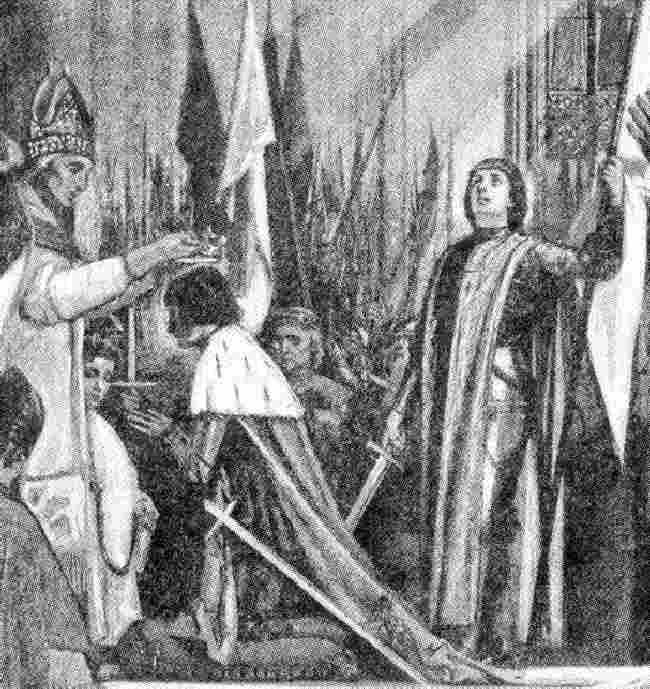
Children in Medieval Europe: Joan of Arc (1412-31)

Figure 1.--Joan of Arc (Jeanne d'Arc) was called la Pucelle (the Maid) and has become the very symbol of the French nation. She was a peasant girl who was born at Domremy in Champagne, about 1412. Here she is pictured in a modern depiction at the coronation of Charles VII which she in large measure made possivle.
|
Joan of Arc (Jeanne d'Arc) was called la Pucelle (the Maid) and has become the very symbol of the French nation. She was a peasant girl who was born at Domremy in Champagne, about 1412. The village was loyal to the French king. Domremy was part of the territory of the Dule of Burgandy. The Burgundians were nominal sujects of the French King Charles VII, but who allied with the English, desired to set up an independent kingdom. At age 13 in the summer of 1425, Joan became conscious of supernatural manifestations, whose she came to call her "voices" or "counsel." Joan carrying an ancient sword entered Orléans on April 30, 1429 which had been threatened by the Burgundians and English. Her presence changed the course of the fighting. Within a few days, English encircling the city were captured and the siege ended. A campaign was launched in the Loire ending on June 18 with a great victory at Patay, where English reinforcements were routed. Jean led forces which took Reims and on July 17, 1429, King Charles VII was
solemnly crowned, Joan standing by with her standard. She was eventually captured and burned at the stake by the English in 1431. Interesingly, George Bernard Shaw reports, although much was written of Joan, no contemporry accounts ever comment that she was atractive. This was unusual in contemporary accounts of women and ugests that she was very plain.
Childhood
Joan of Arc (Jeanne d'Arc) was called la Pucelle (the Maid) and has become the very symbol of the French nation. She was a peasant girl who was born at Domremy in Champagne, about 1412. The village was loyal to the French king.
The Capetian Dynasty was followed by the Valois dynasty. The Valois ruled France from
1328-1589. This meant that the Valois rule from the late medieval era, through the Renaissance and into the modern era. The Valois found France a land divided among important Feudal barons. Some provinces of France such as Burgandy and
Anjou had power which rivaled that of the monarchy. Even more dangerous, they had ties
and alliances to foreign powers. The Valois played a major role in the unification of France and the centralization of power in the monarchy. After the destructive Hundred Years War, the Valois gradually increased the authority of the Crown at the expense of the feudal barons. The Valois established the Crown's exclusive right to
levy taxes and to wage war. The Valois also continued the development of basic national
administrative institutions that had begun to appear under the Capetians. The Parlements
(courts) which first appeared under the Capetians were extended by the Valois throughout to administer royal (national rather than feudal) justice.
Burgandy
Domremy was part of the territory of the Dule of Burgandy. The Burgundians were nominal sujects of the French King Charles VII, but who allied with the English, desired to set up an independent kingdom.
Voices
At age 13 in the summer of 1425, Joan became conscious of supernatural manifestations, whose she came to call her "voices" or "counsel."
Joan carrying an ancient sword entered Orléans on April 30, 1429 which had been threatened by the Burgundians and English. Her presence changed the course of the fighting. Within a few days, English encircling the city were captured and the siege ended. A campaign was launched in the Loire ending on June 18 with a great victory at Patay, where English reinforcements were routed.
Cheles VII
Jean led forces which took Reims and on July 17, 1429, King Charles VII was
solemnly crowned, Joan standing by with her standard.
Execultion
Jean was eventually captured and burned at the stake by the English in 1431.
Physical appearance
Interesingly, George Bernard Shaw reports, although much was written of Joan, no contemporry accounts ever comment that she was atractive. This was unusual in contemporary accounts of women and ugests that she was very plain.
HBC

Navigate the Boys' Historical Clothing Web Site:
[Return to the Main medieval childhood chronology page]
[Return to the Main Medieval page]
[Introduction]
[Activities]
[Biographies]
[Chronology]
[Clothing styles]
[Countries]
[Bibliographies]
[Contributions]
[FAQs]
[Glossaries]
[Satellite sites]
[Tools]
[Boys' Clothing Home]
Created: May 20, 2004
Last updated: May 20, 2004



